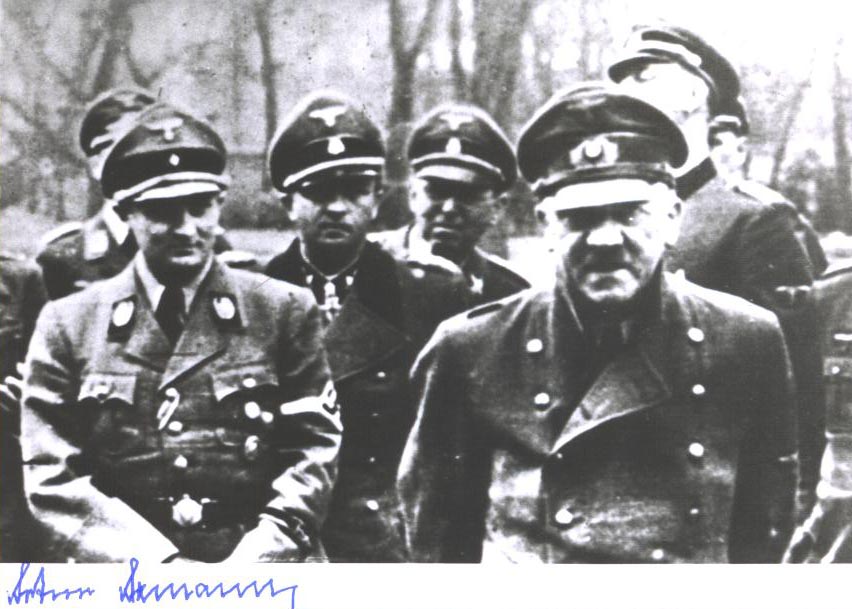
|
~SOLD~ AXMANN Artur
Artur Axmann (18 February 1913 – 24 October 1996)
Early life:
Axmann was born in Hagen on 18 February 1913. In 1928, he founded the first Hitler Youth group in Westphalia. He became very active in the local Nazi Party. Thereafter, he studied law at school.
Nazi career:
In 1932, he was called to be a Reich Leader (Reichsleiter) of the Nazi Party (Nationalsozialistische Deutsche Arbeiterpartei or NSDAP) to carry out a reorganisation of Nazi youth cells. In 1933, Axmann became Chief of the Social Office of the Reich Youth Leadership. He directed the Hitler Youth in state vocational training and succeeded in raising the status of Hitler Youth agricultural work.
War service:
He was on active service on the Western Front until May 1940. In August of the same year Axmann succeeded Baldur von Schirach as Reich Youth Leader (Reichsjugendführer) of the Nazi Party. In 1941, he was severely wounded on the Eastern Front, losing an arm.
During the last weeks of the war, Axmann commanded units of the Hitler Youth (Hitlerjugend), which had been incorporated into the Home Guard (Volkssturm). His units consisted mostly of children and adolescents. They primarily fought in the Battle of Seelow Heights (Seelower Höhen), which was a part of the larger Battle of Berlin (Endkampf um Berlin).
On 4 January 1944, Axmann was awarded the German Order, the highest decoration that the Nazi Party could bestow on an individual, for his services to the Reich. He and one other recipient, K. Hierl, were the only holders of the award to survive the war and its consequences. All other recipients were either awarded it posthumously, or were killed during the war or its aftermath.
During 1945, Axmann was pressured to let young women be conscripted into combat roles for the last defence of Germany. Although Axmann had permitted young boys to fight in the final days, he refused to allow girls to fight. He stated, "Women bring life into the world, they do not take it."
Breakout:
During Hitler's last days, Axmann was among those present in the Führerbunker. On 30 April 1945, just a few hours before committing suicide, Hitler signed the order to allow a breakout. On 1 May, Axmann left the Führerbunker with SS doctor Ludwig Stumpfegger and Martin Bormann as part of a group attempting to break out of the Soviet encirclement. Their group managed to cross the River Spree at the Weidendammer Bridge.
Leaving the rest of their group, Bormann, Stumpfegger and Axmann walked along railway tracks to Lehrter railway station. Bormann and Stumpfegger followed the railway tracks towards Stettiner station. Axmann decided to go alone in the opposite direction of his two companions. When he encountered a Red Army patrol, Axmann doubled back and later insisted he had seen the bodies of Bormann and Stumpfegger near the railway switching yard (Stettiner Bahnhof) with moonlight clearly illuminating their faces. He did not check the bodies, so he did not know how they died.
He avoided capture by Soviet troops and disappeared. Axmann, presumed dead, lived under the alias of "Erich Siewert" for several months. Axmann was arrested in December 1945 when a Nazi underground movement which he had been organising was uncovered by a U.S. Army counterintelligence operation.
Trials:
In May 1949, a Nuremberg de-Nazification court sentenced Axmann to a prison sentence of three years and three months as a 'major offender'.
On 19 August 1958, a West Berlin de-Nazification court fined the former Hitler Youth leader 35,000 marks (approximately £3,000, or $8,300 USD), about half the value of his property in Berlin. The court found him guilty of indoctrinating German youth with National Socialism until the end of the Third Reich, but concluded he had been a Nazi from inner conviction rather than base motives. During his trial, Axmann told the court he heard the shot by which Hitler committed suicide. He also stated he had attempted to escape from central Berlin along with Martin Bormann, who he said had died during the attempt.
Post-war life:
After his release from prison, Axmann worked as a sales representative in Gelsenkirchen and Berlin. He eventually became a prosperous businessman.
Axmann died in Berlin in 1996.
From Wikipedia, the free encyclopedia
AXMANN Artur
(1913 - 1996)
Reichsleiter / Reichsjugendfuhrer / M.d.R.:
Born: 15. Feb. 1913 in Hagen / Westfalen. Died: 24. Oct. 1996 in Germany.
NSDAP-Nr.:
Assignments:
Reichsjugendführer: Aug. 1940 - May 1945.
Army Service: Sep. 1939 - 1941 (served on Western and later Russian Fronts, until losing his right arm in combat).
Chief, Social Office, Reichsjugendführung: 1933-1940.
Entered Reichsjugendführung: 1932.
Founder of first Hitlerjugend group, Westfalen: 1928.
Decorations & Awards:
Das Goldenes Kreuz des Deutschen Ordens (The Golden Cross the German Order): 28. 04. 1945;
1939 EK I: 04.1945; 1939 EK II: 1941; KVK I ohne Schwerter; KVK II ohne Schwerter
Verwundetenabzeichen, 1939 in Silber (lost right arm, Eastern Front, 22. Jun. 1941);
Goldenes Parteiabzeichen;
Goldenes Hitler-Jugend Ehrenzeichen mit Eichenlaub;
Dienstauszeichnung der NSDAP in Silber.
Information courtesy of Axis Biographical Research
Price: $0.00
Please contact us before ordering to confirm availability and shipping costs.
Buy now with your credit card
other ways to buy
|


